Rick Darlington’s Single Wing Power Series

Hmmm, a single wing talk at the National Wing-T Clinic? I was intrigued for sure. I first learned the ins and outs of the single wing when I read Dave Cisar’s Winning Youth Football which features a modified version appropriate for youth football bobble heads. There’s certainly a shared heritage between the Wing-T and single wing. I’m sure single wing coaches chuckle at wing-t coaches who decide to run “shotgun Wing-T with an unbalanced line”. Hey, just allow direct snap to either the QB or TB and you are now running a single wing!
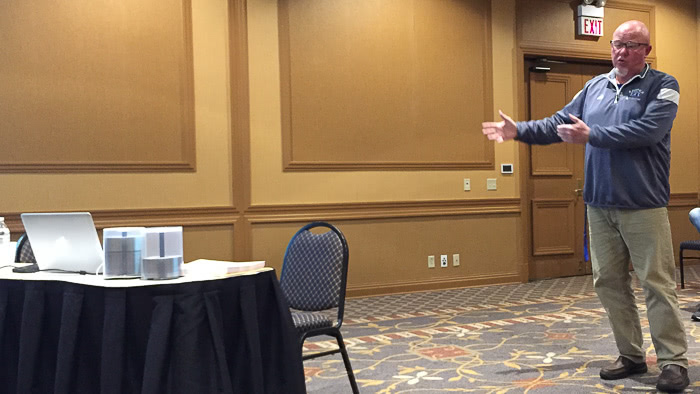
Rick Darlington is the head coach at Apopka High School in Florida, and his record there as 151–39. I’ve never coached in Florida, but I suspect the talent gaps can be huge there between different programs so having this level of consistency reflects well on the quality of coaching. Rick said he adopted the single wing as he entered a season without a QB – someone said “you should run the single wing!” I guess he had to Google it to find out what it was.
If you like what you see here, make sure you head over to Rick’s site and consider purchasing his materials. He has extensive videos along with voiceovers showing more details of the play diagrams and line calls.
This first article is on Rick’s power series which would be very easy to incorporate into a Wing-T offense. I’ll write one more article about his spinner series, then another about how he has incorporated the run-pass option (RPO) into the single wing.
Why Run the Single Wing?
Rick likes the single wing because:
- He doesn’t have to have a QB-type player. If he does, that’s a bonus.
- The opposing defensive scheme doesn’t matter – he always has an answer
- No QB means he has an extra blocker on every play
- It is a physical, hard nosed offense. He likes having offensive linemen that are in a 3-point stance and fire off to hit people. He does not like seeing the OL in a 2-point stance, backing up at the snap, and playing patty-cake with the defense.
- He gets more numbers at the point of attack than there are defenders
- It is difficult for opponents to simulate and prepare for
- He has developed a feeder program with the youth and middle school programs
- He can control tempo
- His linemen become specialists
Interesting - that list of bullets could almost substitute as a “why run the Wing-T” list.
The Basics of Rick’s Single Wing Power Series

Above you can see the basic strong right formation. Rick flips his line and he believes this leads to better player specialization. Player specifics:
- TE – the tight end will normally line up tight on the weak side.
- QG – the quick guard is the weak-side guard
- C – the center must be adept at the short, knuckle-ball snap to either the FB or TB, though in most cases the snap will be directly backward with the back responsible for getting himself in position to receive it.
- PG – the power guard is the strong-side guard
- IT – the inside tackle can be the weakest OL player
- OT – the outside tackle must be able to down, on, and reach block
- R – receiver
- WB – the wing back is like a Wing-T wing back in that he must be a good blocker in space plus be able to carry the ball in the counter game
- BB – the blocking back is a power-I FB type player, usually blocking and often a kickout
- FB – running back and blocker. Primary RB in the trap game. May also be asked to throw the ball.
- TB – the primary running back in this offense. Will need to be able to throw the ball.
In Rick’s offense he uses “Darter” for right, “Blue” for left.
Power Sweep - “8”
The first play is the power sweep play. If he wants to call power sweep to the right, the call would be “Darter 8” followed by a tag that indicates the blocking scheme or even a play variation like a naked boot.
Quick Diversion: Rick’s Concept of Play Ownership
Rick has an interesting concept he’s integrated into his series-based play calling system. Every base play has an owner: a coach or an offensive lineman who is in the best position to make a call to vary the blocking scheme or even the point of attack. The power sweep (8) play is owned by the coach because the play attacks the flank and, in his experience, the coach is in the best position to make the adjustment. As you’ll see with the next play (power, or “6”) an offensive lineman may be the play owner. Each play will have just a single owner, and a given player (or coach) will own just a single play. I like the simplicity and elegance of this approach. It also forces an economy of plays in the system but allows for multiplicity with the different blocking schemes.
The Play
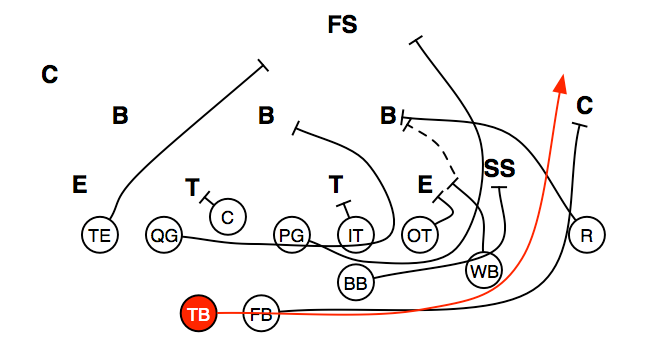
Let’s get back to 8. The base call is Blood, so the full call for power sweep to the right would be “Darter 8 Blood”. The rules for each player are:
- TE – cutoff
- QG – travel for LB 2, look for penetration
- C – A gap DL
- PG – pull for safety
- IT – base reach if covered / fill for pulling guard if uncovered
- OT – double with the WB
- WB – double with the OT, hope to bump to LB 1.
- R – blood LB 1. Blood is a crack block to the first linebacker inside the force player.
- BB – reach force player, stretching flat for three steps then getting his head outside the force player.
- FB – read BB for corner back
- TB – ball carrier, follow FB. His path at the snap takes him directly behind the center to receive the ball
The OT and WB looks like a zone / reach step, and they work on stepping together to ensure they stop the DE. If the OT is successful in his reach, the WB can climb to the second level.
Coach Darlington uses the rule chase, which is a backside rule that usually involves a fake or influence and has that player then turn back to playside at second level to give chase and be a screen or downfield blocker.
Rick numbers his linebackers LB 1, 2, etc. LB 1 is first LB inside force, 2 is second, etc.
Another term to learn: travel means that a puller crosses the center. Rick has the traveler / puller take a pre-snap look to find the number of the player he will block.
They teach the BB to maintain his reach the whole way by putting his head outside and continuing to strive for reach position with his hips outside. In Rick’s opinion, the force player is usually taught to keep his outside arm/shoulder free to fight this reach, and the BB can use this against him by reach-stretching the player to the sideline. This is why the FB will read the BB block: if he sees the BB stretching the reach outside, the BB will cut up inside for his block on the corner.
Power Sweep 8 Variations
Here are some variations Rick talked about. Remember the above base play is “8 Blood”.
- Darter 8 Bang – The BB and PG go opposite the play (he calls this “travel weak”) to give a false key to the defense. The weak pull makes it look like counter, so this is a sucker pull. Run this early in the game as a key breaker. Also, backside guard will just reach.
- Darter 8 Lightning – Lightning is a “weather” term, and Rick teaches the concept of a “weather block” which is a crack block on the force player by the R. Contrast this with the Blood call where the R goes to the first linebacker inside force, requiring the BB to reach the force player. The rest of the line (not the PG) reaches to play side. The WB now has a reach / log block on LB 1, the BB goes to corner, and the FB goes to safety. Rick claimed that this is his best sweep play, and he loves running this at the goal-line.
- Darter 8 WAR – WAR stands for “WB And Receiver”, so WAR indicates that the WB and R will double-team the force player.
You may have noticed that Rick’s rules call out a specific player (safety, corner, etc.). This is exactly how he teaches his blocking rules (and reinforces against scout defense): he names position players and doesn’t use language like “first threat outside DE”. Food for thought, as this is certainly not how I’ve taught blocking rules in the past.
Power – “6”
The “6” play is the classic Power. The coach calls the play (e.g. “Darter 6”) but the owning player calls the variation. For Power, the owning player is the OT. The base call is “Tight”, when the IT is covered and there are 2 defenders outside this DL. So the diagram below is for “Darter 6 Tight”.
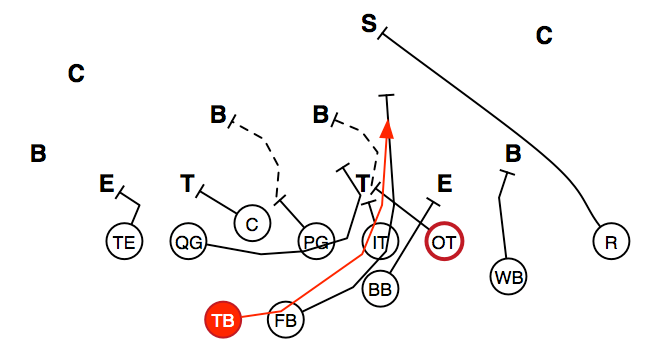
Before I show the rules, here’s a word Rick uses for Gap/Down/Backer: Railroad. The players visualize being on railroad tracks. If they don’t find a DL in first three steps, go to second level.
- TE – Tag out – I think this is just blocking back on the weak DE
- QG – Skip pull LB 1
- C – Back
- PG – Railroad
- IT – Railroad
- OT – Railroad – goal is that either the inside or outside tackle will get to a backside LB.
- WB – Attack force
- R – Stab - stalk the safety. We will not block the corner.
- BB – Kick out DE, step at inside foot of the OT.
- FB – Lead inside BB to LB 1
- TB – ball carrier, slide (keep shoulders square to LOS), follow FB
Rick teaches the QG and FB to “hold hands through the hole” which helps them maintain perfect relative position (QG is inside) and avoids blocking conflict. My guess in the diagram above is that the FB would end up going to safety while the QG turns in on the LB and possibly help with the OT.
Power 6 Variations
Remember, the OT is the owner of this play so will make these calls based on what he sees. The first thing he does is look inside – is there a man on the inside tackle? If so, look from head up on him to ouside on the line. If there are two men, make a tight call. If just one, make a loose call.
- Darter 6 Loose – In this case, force player becomes the kick out for the BB, the WB goes to corner. This obviously moves the point of attack outside 1–2 gaps.
- Darter 6 Tunnel – If there’s nobody in the C gap, but somebody in the B and D gap, they will call Tunnel (usually 4–3 defense). With the tunnel call, the BB and OT switch assignments and the OT kicks out the DE with the BB going inside to backer.
Counter - “7”
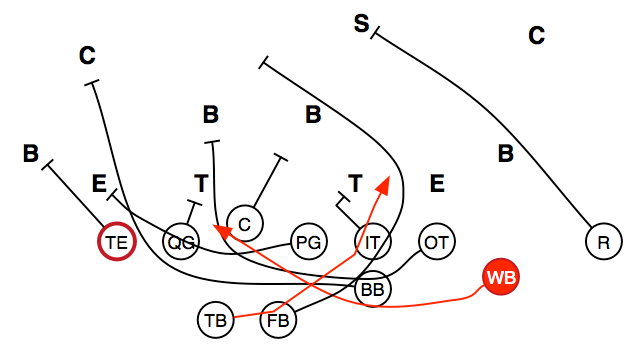
The Counter play off Power is “7”, so “Darter 7” will be a counter run to the weak side (left). The TE (who is in a traditional weak tackle position) is the owner of this play.
- TE – Whale / Bo. If there’s an uncovered QG and a 5-tech that is squeezing, the Whale call has him block out the overhang player, usually the corner. Dolphin is a down block. Remember the TE owns the play so he makes the call. The BO call is a combo with the QG, which tells the BB that he will have to go to the overhang player.
- QG – Down
- C – Base to Back
- PG – Trap TE area
- IT – Base to Chase
- OT – Travel to LB 1
- WB – Open, receive inside hand-off and find hole just past center
- R – Cutoff
- BB – Travel to overhang
- FB – Chase
- TB – Take snap with same footwork as power, inside hand-off to WB
Counter 7 Variations
- Darter 7 Wrong – The BB, instead of pulling, will chase from the backside to give a stronger Power read. I think Rick said he would script this early to see how the LBs are reacting. Are they keying the BB? Then influence plays like this will be effective. The FB, instead of chasing, will jab like he is leading on Power, then turn to travel and block the overhang player
- Darter 7 Plus – This is like the base counter play, but the FB will jab step like he does on Wrong then lead up the funnel with the OT. Rick says this is his favorite variant of 7 - four pullers!
ISO – “4”
This is a traditional ISO play to the strong side, with the IT owning the play. The BB is leading for the FB who take a direct snap, while the TB runs fake Power Sweep action. Rick didn’t talk much about this play but I’ll try to piece together the calls and rules for it. The base version of this is Bama.
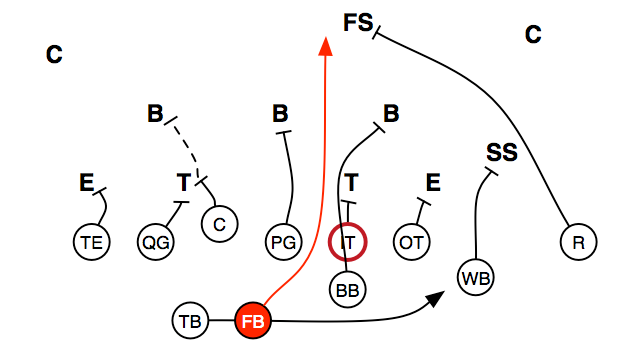
- TE – Backside corner back
- QG – Base
- C – Ace (Reach)
- PG – Ace to LB 2
- IT – Base Out
- OT – Base Out
- WB – Attack Force
- R – Stab
- BB – Insert for LB 1 – should be in B gap between C and IT
- FB – Take direct snap and follow BB
- TB – Fake Power Sweep
ISO 4 Variants
Rick only had a single variant:
- Darter 4 Charlie – The IT, instead of blocking his Base Out rule, climbs to LB 2. The PG also climbs with a reach technique. The C base blocks. I’m not sure about the read for the IT on this, but my gues would be if that if he has a man outside shade to C gap, he will call Bama and block out. If there’s a man inside that the PG can base or reach, he will call Charlie.
Closing Thoughts
That’s it for the Power Series. As a Wing-T coach, what can you take from this? I’ve got a few ideas:
- Consider applying the concept of “someone owns the call for each play” to your own core series plays. I could see this working for Buck and Belly series, for example. TE owns Down, QT owns Down Counter, WB owns Buck Sweep, C owns Buck Trap, QG owns weak-side Belly, coach owns Belly Sweep. If you like to run fewer plays with multiple blocking variants, this might be a nice tweak to your system and streamline your calls and instill ownership and accountability.
- If you are running pistol or shotgun Wing-T and have a QB that can run the ball, I think it would be easy to motion your way into a formation that opens up this series for you. When we run with an end-over formation, we flip the TE and QT anyway to make sure we don’t have an overweight player in an uncovered position. Shuffle motion your weak WB to the BB position from a shotgun Wing-T double-wing formation and you look just like an unbalanced single wing.